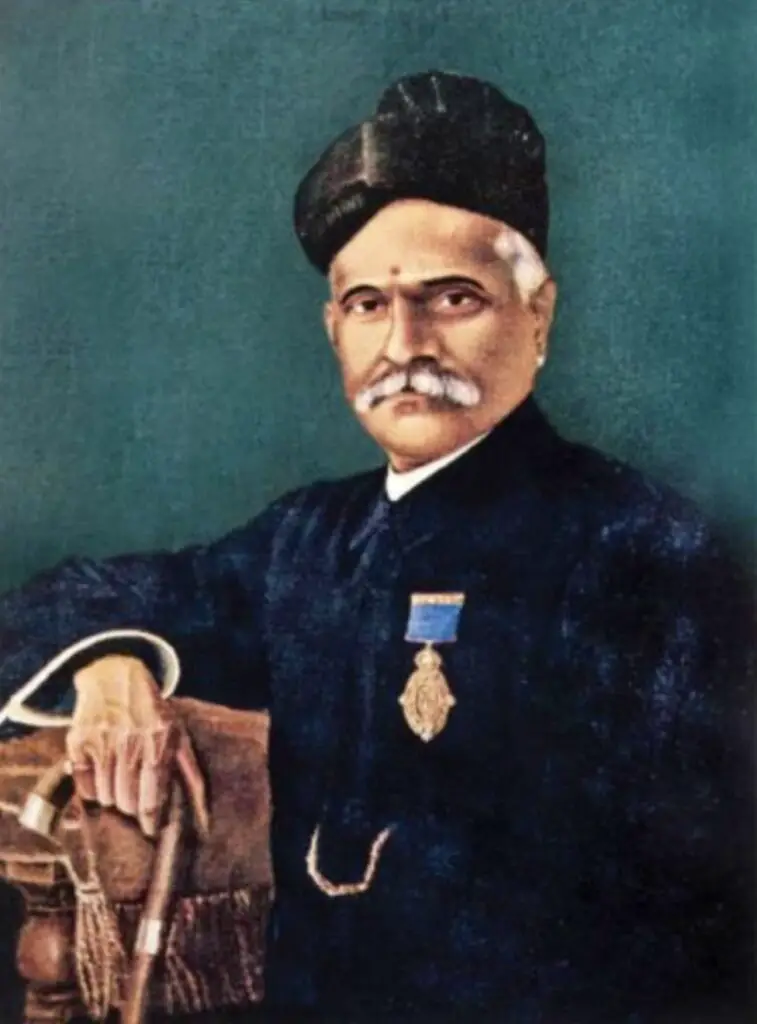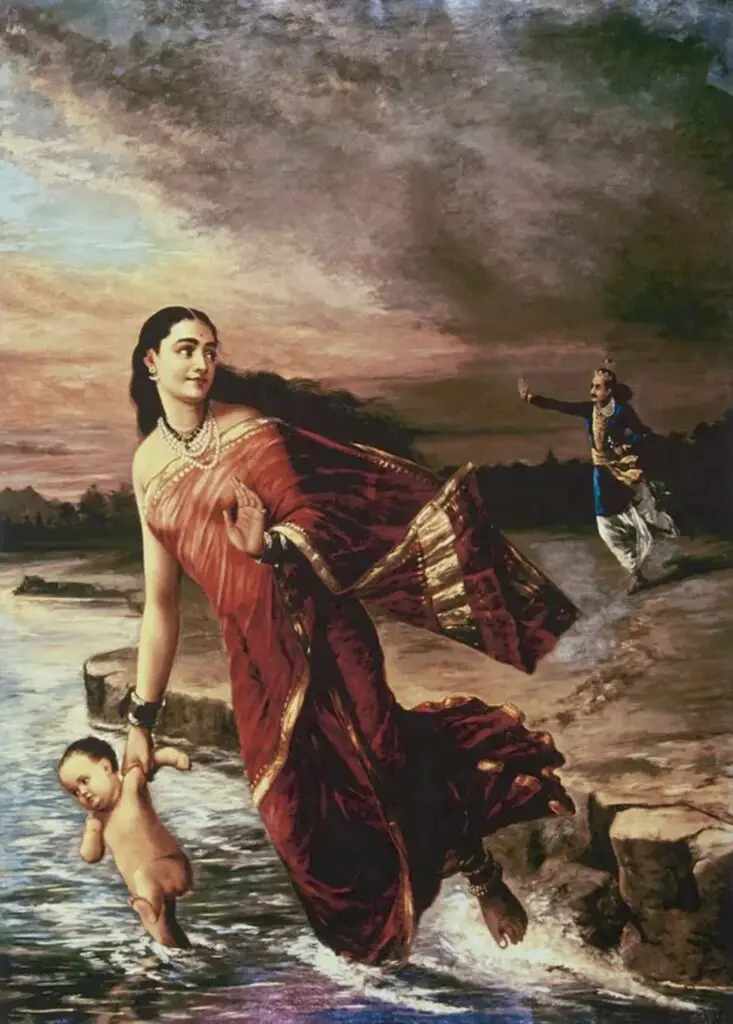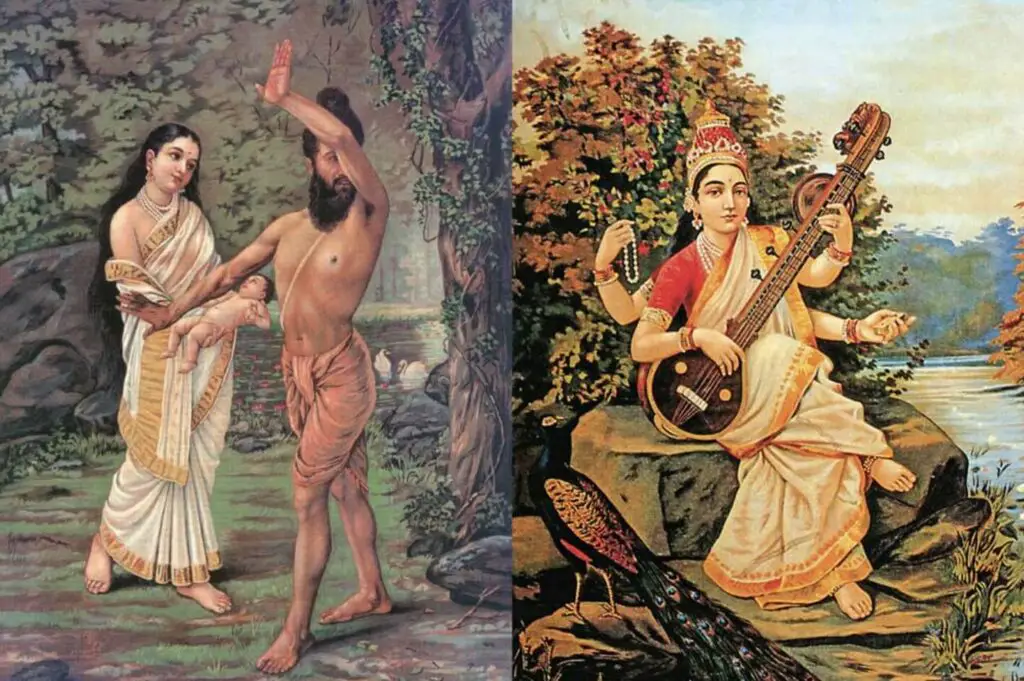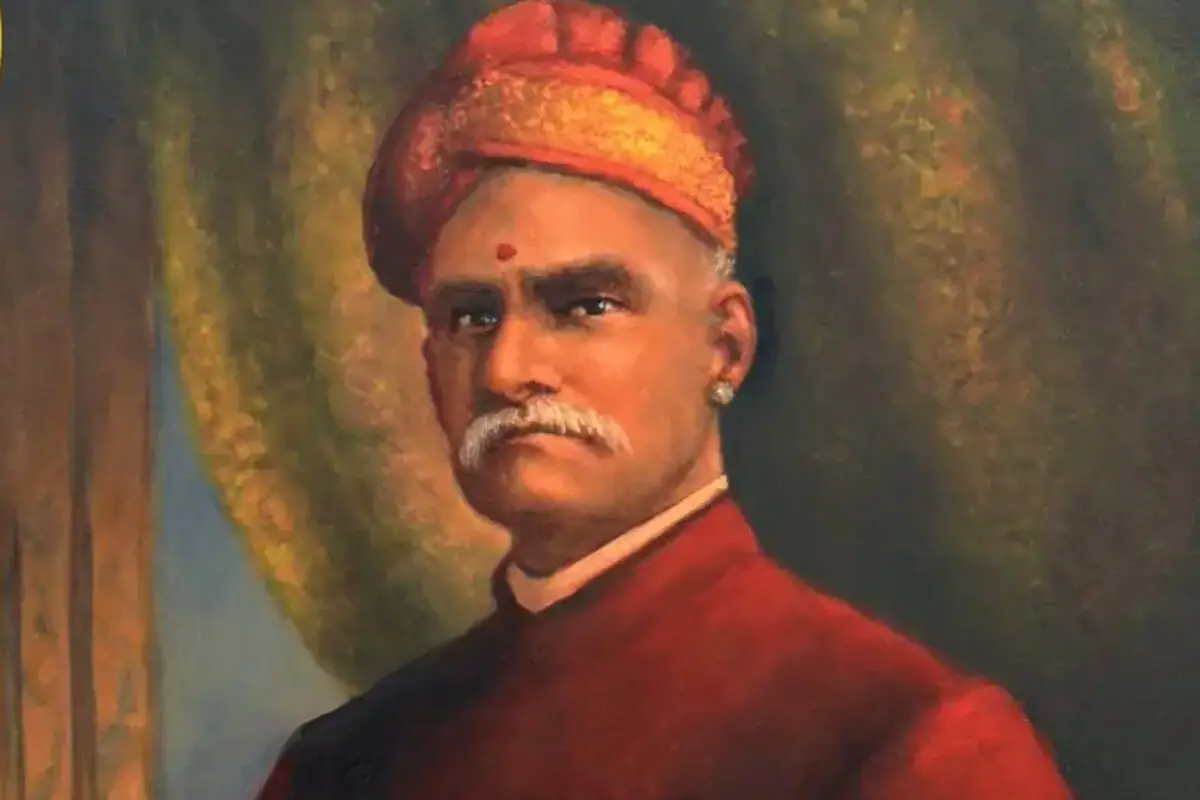Raja Ravi Varma’s contributions to the Indian art scene have left an indelible mark transcending time and cultural boundaries. His life’s work, a testament to the harmonious blend of Indian themes with European techniques, continues to resonate with and inspire artists, scholars, and art lovers around the globe.
This narrative seeks to illuminate how Varma’s artistic endeavors have not only enriched the visual arts but also profoundly impacted Indian society and culture at large.
Table of Contents
- Raja Ravi Varma’s Life and Legacy
- Techniques and Themes
- Impact on Indian Society and Culture
- Controversies and Criticisms
- Raja Ravi Varma in Modern Times
- Related Questions
Raja Ravi Varma’s Life and Legacy
Raja Ravi Varma was born in 1848 in the princely state of Kilimanoor, Kerala. He showed an early talent for art, which his uncle, Raja Raja Varma, nurtured. Unlike many artists of his time, Varma received formal training in watercolor painting and was later introduced to oil painting, a medium that was not widely used in India then. His exposure to European art forms came from his travels, and his interactions with British artists greatly influenced his style.
Varma’s ability to mix Indian mythological themes with European realism and techniques quickly earned him recognition. He became famous for his paintings of Hindu gods and goddesses depicted as realistic human figures set against the backdrop of Indian landscapes and everyday life. This approach made his artworks relatable, bringing gods and goddesses from the realm of the ethereal into the living rooms of the common man.
In 1873, Varma won the first prize at the Madras Painting Exhibition. He was the first Indian artist to use a European oil painting style, and he mastered the art of chromolithography, which allowed for the mass production of his works. This endeavor democratized art in India, making Raja Ravi Varma’s prints affordable and accessible to a broader public, vastly influencing Indian visual culture and iconography.
Varma’s legacy is monumental. He bridged the gap between traditional Indian art forms and the European academic art style. He was critical in shaping modern Indian art, inspiring generations of artists. His layering, perspective, and composition techniques have been assimilated into various modern Indian art forms.
Moreover, Raja Ravi Varma’s depictions of Indian gods and goddesses have significantly influenced how these deities are visualized in popular culture today, including in films, television, and religious publications. His portrayal of epics like Mahabharata and Ramayana brought these stories to life, rendering them in a form that has become canonical to their depiction in Indian society.
Despite passing away in 1906, Varma’s influence permeates contemporary Indian art. Many modern artists, such as M.F. Husain, have cited Ravi Varma as an inspiration. His works continue to be exhibited and fetch high prices at auctions worldwide, a testament to his enduring appeal.
Thus, Raja Ravi Varma remains a stalwart figure in the annals of Indian art history. His innovative blending of Indian themes with Western techniques paved the way for future artists, and his legacy continues to inspire and resonate across cultures and generations.

Techniques and Themes
Raja Ravi Varma excelled in portraying the female form in a manner that balanced sensitivity with grace, a testament to his deep understanding and reverence for Indian femininity and mythology.
His depictions went beyond mere representation, venturing into the realm of idealization without losing touch with earthy realism. Varma’s women, whether divine figures or mortals, embodied the quintessence of beauty and nobility, effectively capturing the viewer’s imagination.
His palette choice played a crucial role in bringing his subjects to life. Varma favored vibrant yet harmonious colors that enhanced the expressive quality of his paintings. Whether it was the rich drapery of sari fabric or the subtle hues of dawn, his adept use of color added depth and movement, making each scene or character pulse with vitality.
Another notable aspect of Raja Ravi Varma’s work was his unique approach to lighting. Influenced by his observations of European art, he mastered using light and shadow to lend a three-dimensional effect to his canvases. The meticulous attention to the play of light highlighted the realism in his work and contributed to the dramatic intensity of the narratives depicted.
Varma’s interest in capturing fleeting expressions and diverse emotions showcased his remarkable ability to humanize celestial beings, bringing gods and goddesses into the realms of earthly understanding. This emotional connectivity bridged the gap between the divine and the mortal, rendering his mythological characters relatable to the common man.
His scenes from epics like Mahabharata and Ramayana did more than narrate ancient tales; they echoed the moral and ethical struggles faced by individuals, making these historical and religious narratives accessible and relevant to a broader audience. Through his artwork, Varma engaged in a silent dialogue with the viewer, encouraging introspection and a deeper understanding of cultural heritage.
Furthermore, Raja Ravi Varma’s skill in oil painting allowed him to incorporate intricate details – from jewelry design and textile patterns to architectural elements. This showcased his observational precision and documented the richness of Indian culture and traditions during his time.
Varma’s work, characterized by an elegant fusion of themes and techniques, laid the foundation for modern Indian art. By making gods and goddesses more approachable, he forged a personal connection between these deities and the Indian populace, changing how they are perceived and worshipped today.
In sum, through his innovative use of European techniques to depict traditional Indian themes, Raja Ravi Varma offered a window into the soul of India—its aspirations, cultural ethos, and timeless spirituality. His paintings remain a beacon of cultural pride and artistic achievement.

Impact on Indian Society and Culture
Raja Ravi Varma’s skill in presenting divinity in a tangible form revolutionized religious narration, making epics and Puranas more approachable to the everyday Indian. His portraits allowed for visualization of religious tales that were, until then, confined to Sanskrit verses incomprehensible to the common populace. This visual representation fostered a deeper connection with the spirituality rooted within these stories, widening the scope of religious practices and making worship more intimate and personal.
Varma’s establishment of the Ravi Varma Lithographic Press was a monumental step in making artwork a household staple, moving beyond the exclusive reach of aristocracy and temples. Ordinary individuals now had access to previously unattainable art, democratizing spiritual images and narratives. This access did not just alter worship practices but also helped educate the masses about their own culture and mythologies through visual stories.
Moreover, Varma’s art played a critical role when India was under colonial rule, acting as a tool for cultural preservation and assertion against British cultural dominance. By depicting Hindu gods in a style that resonated with both Indian tradition and European techniques, Varma subtly countered the colonial narrative that Indian culture was inferior. His art became a point of cultural pride, a reminder of the richness of Indian heritage in the face of foreign subjugation.
The establishment of the lithographic press democratized art and sparked a new industry in India—the printing industry. This boosted the economy and opened new avenues for the creative and commercial sectors. Varma’s widespread reproductions influenced other forms of media, from textiles to pottery, embedding his iconic style into the fabric of Indian culture.
Lastly, it’s essential to recognize how Raja Ravi Varma’s work has percolated to contemporary times, influencing modern advertising, cinema, and fashion. His depiction of gods and goddesses in traditional attire has shaped costume design in Indian cinema, and his influence can be seen in commercial advertisements that use mythological motifs to connect deeply with the Indian populace. Varma’s artwork inspires fashion designers who blend traditional Indian aesthetics with contemporary styles, further showcasing his lasting impact on Indian culture and society.
Thus, Raja Ravi Varma did not just leave behind a legacy of paintings but laid the foundation for a cultural phenomenon that extended far beyond the canvases he painted on. Through his visionary work and innovations, he redefined Indian art and culture, creating a bridge between the divine and the mortal, the mythical and the every day, continuing to influence generations long after his time.
Controversies and Criticisms
Despite the acclaim and groundbreaking achievements Raja Ravi Varma garnered, his career wasn’t without its controversies. As he integrated Western methodologies with Eastern themes, many traditionalists saw his work violating the sacred, creating a cultural tug-of-war.
Varma faced significant backlash for portraying Hindu deities in a humanized, accessible form. Critics argued this approach stripped these figures of their divine mystique, presenting them in a light far removed from their revered status in Hinduism.
Adding to the controversy, Varma’s method of mass-producing religious images through his Lithographic Press was revolutionary yet contentious. Some viewed this democratization of art as diminishing the sanctity of divine figures, transforming sacred icons into commercial commodities. This commercialization raised questions about the line between accessibility and trivialization of religious symbols.
The legal landscape of the time also posed challenges for Varma. In an era of developing copyright laws, Varma navigated through legal hurdles to protect his work from unauthorized reproductions. Despite these efforts, his pioneering use of chromolithography led to widespread imitation and reproduction of his art, complicating copyright issues and affecting the perceived value of his original works.
Societal challenges were equally daunting. Varma’s depictions often crossed conservative boundaries, presenting goddesses and mythological heroines in a manner that some considered too revealing or Westernized. This ignited debates on the portrayal of Indian femininity and culture, raising questions about the impact of Western influence on traditional Indian values and aesthetics.
Debates on Varma’s legacy underscore the complex relationship between innovation and tradition. While some accuse him of diluting Indian art traditions with European influences, others celebrate him for elevating Indian art onto a global platform. His technique of portraying divine figures in relatable settings disrupted traditional iconography and forever changed the embodiment of gods and goddesses in visual culture.
The controversies surrounding Varma further emphasized the changing landscape of Indian art during his time. It showcased the struggle between upholding tradition and embracing modernity, a balance Varma navigated throughout his career.
Ultimately, Raja Ravi Varma remains a figure whose work prompts debate even in contemporary times. The conversation he started—about cultural authenticity, the role of art in society, and the tensions between innovation and tradition—continues to inspire and provoke. His ability to stir such discourse underscores his significance as an artist and as a pivotal figure in the narrative of Indian cultural history.
Raja Ravi Varma in Modern Times
Raja Ravi Varma’s paintings continue to function as a rich source of inspiration in modern art, cinema, and fashion, illustrating the timeless nature of his work. Today’s artists frequently draw upon Varma’s techniques and themes to create art that bridges the past with the present.
Filmmakers weave Varma’s iconic depictions into their visual storytelling, using his art as reference points to design sets, costumes, and even shot compositions that echo the aesthetic of his paintings. Fashion designers, intrigued by the elegance and realism of Varma’s portrayal of traditional Indian apparel and jewelry, reinterpret these elements in contemporary designs, thereby sustaining Varma’s influence over Indian fashion trends.
The accessibility of Raja Ravi Varma’s artwork, propelled by his innovative approach to art distribution through lithographs, presages the current digital art movement. His ethos of making art accessible to the general populace mirrors today’s digital galleries and virtual exhibitions, which strive to democratize art appreciation and accessibility. His initiative inadvertently laid a conceptual groundwork for present-day efforts in digital preservation and online sharing of artworks.
Recent exhibitions dedicated to Varma’s originals and reprints highlight an ongoing interest and scholarly reassessment of his contributions to Indian and global art history. His works continue to fetch high prices at auctions, signaling investment value and deep-seated admiration and respect for his artistic legacy. Furthermore, the digitalization of Raja Ravi Varma’s oeuvre underscores the ongoing efforts to preserve and share his work with broader audiences worldwide, making his masterpieces accessible across digital platforms.
Varma’s methodology, melding European techniques with Indian themes, essentially cultivated a visual language many Indian artists still employ. His work allows ongoing conversations about cultural identity, heritage, and the evolving nature of art in reflecting society’s values and changes. By contemporizing mythological narratives, Varma created a template for how stories from India’s rich tapestry of folklore and mythology can be retold in a resonant manner for future generations.
In conclusion, Raja Ravi Varma’s work profoundly influences various domains within contemporary culture and art. His legacy endures, making evident the strength and vitality of his artistic vision in the never-ending dialogue between tradition and modernity.

In essence, Raja Ravi Varma’s legacy is a vibrant tapestry that weaves together the rich hues of Indian tradition with the intricate patterns of Western artistic methods.
His ability to render the divine in a form that speaks directly to the human spirit remains his most enduring contribution. His work bridges worlds and touches hearts across generations. Varma’s work is a beacon that continues to guide the path of Indian art toward a future where tradition and modernity coexist in beautiful harmony.
Anita Louise Art is dedicated to art education, great artists, and inspiring others to find and create their art. We love art that uplifts and inspires. #ArtToMakeYouSmile! #ArtToMakeYouHappy!
If you are interested to see any of my art, you can find out more by clicking here. If you are interested in what inspires me and my paintings, you can discover more by clicking here.
We have a free newsletter and would love you to be part of our community; you can subscribe to the newsletter by clicking here. If you have any questions, I would be happy to talk to you. You can reach me, Anita, by clicking here.
Subscribe to our Anita Louise Art YouTube Channel with great videos and information by clicking here.
Join us for our podcast “5 Minutes With Art.” Spend just 5 minutes a week with us to discover and learn about great art and artists. You can find out more about our podcast by clicking here.
Related Questions
What Makes Jackson Pollock’s Art So Valuable?
Jackson Pollock was a brilliant and creative artist who was not afraid to try new techniques with art. He is known for being a founder of Abstract Expressionism and the gestural technique, also known as action painting. He never saw much success in his lifetime, but today his painting fetch millions of dollars and are considered extremely valuable.
By clicking here, you can discover more by reading What Makes Jackson Pollock’s Art So Valuable?
Did They Use An Original Jackson Pollock Painting In Ex Machina Or A Replica?
They would have used a copy of this painting No 5 (1948) as the painting was sold by David Geffen, a Hollywood producer, and film studio executive, for over $140 million USD in 2006. Geffen would have sold the painting long before the movie was produced, and no respectable art collector would place such a valuable work of art on a film set or studio.
By clicking here, you can learn more by reading Did They Use An Original Jackson Pollock Painting In Ex Machina Or A Replica?
How Much Is The Jackson Pollock Painting Worth In The Movie “The Accountant”?
We do not know precisely how much the Jackson Pollock Free Form painting is worth, but we know that it is owned by the Museum of Modern Art in New York City, and the painting in the movie The Accountant is a reproduction or copy. We know that similar Jackson Pollock paintings have sold for over $100 million. So we know that Jackson Pollock’s paintings are precious in today’s art market.
By clicking here, you can learn more by reading How Much Is The Jackson Pollock Painting Worth In The Movie “The Accountant”?

